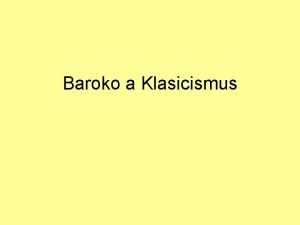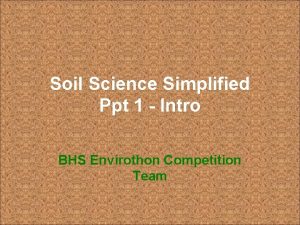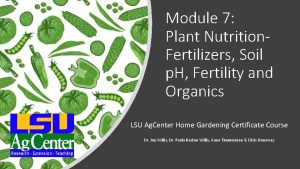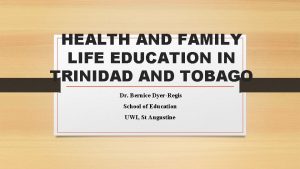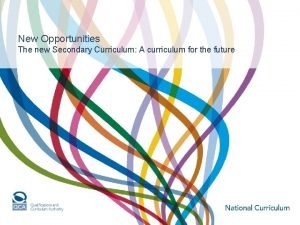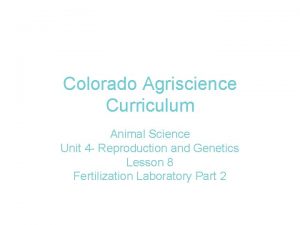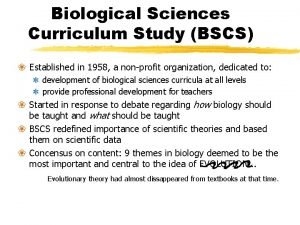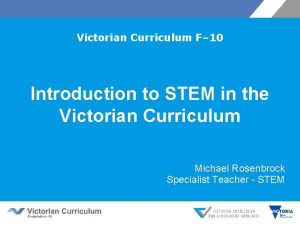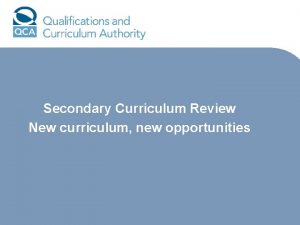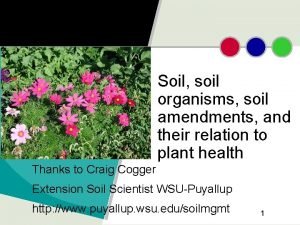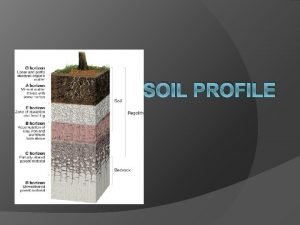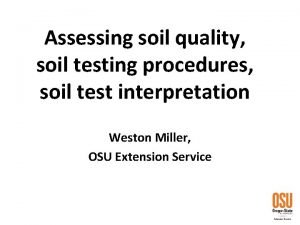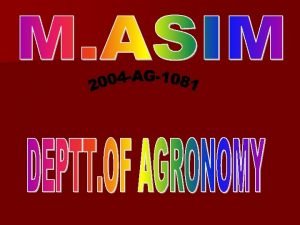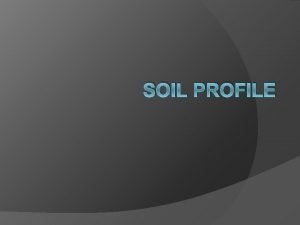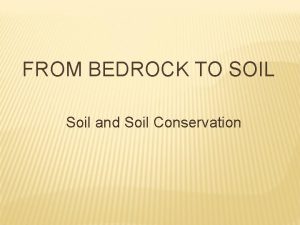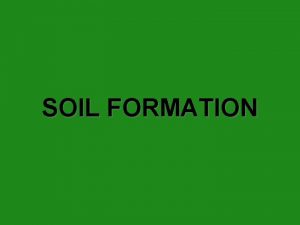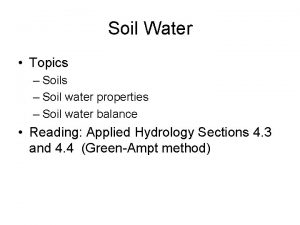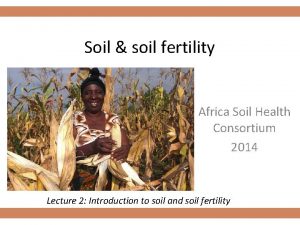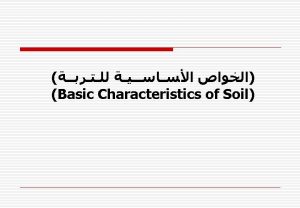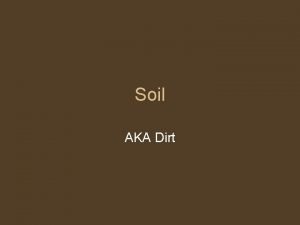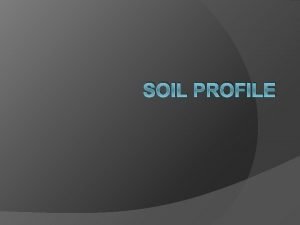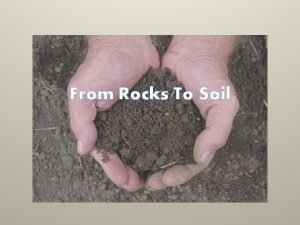Developing a Secondary Soil Science Curriculum Davida R























- Slides: 23

Developing a Secondary Soil Science Curriculum Davida R. Molina AED 615

Personal Background National FFA/4 -H Land Judging Contest Willcox Soil Judging Team Oklahoma - 2004 National Collegiate Soil Judging Competition University of Arizona Soil Judging Team Illinois - 2004

Chapter 1

Introduction Soil Science is an integral component in the Agricultural Education curriculum. Arizona Agricultural Instructors are in need of a user friendly resource which challenges students academically and provides real life applications.

Need • Replace or use in conjunction with outdated curriculum materials • Meet Arizona State Standards • Implement Science into Agricultural Education Programs

Purpose Statement The purpose of this curriculum project is to develop a teacher reference unit which assists secondary agricultural educators in teaching soil science.

Objectives • Review the current curriculum materials available in soil science • Review reference materials available in soil science • To create a teacher reference unit that: – a) Includes all components of a lesson and is teacher friendly – b) Meets current Arizona Department of Education standards – c) Provides an Agriscience curriculum with

Limitations • The information is tailored for the use in Arizona agricultural education programs

Assumptions • Arizona Agricultural Educators have a basic soil science background • The curriculum will continue to address the future changes which may occur in the science and CTE standards

Terms • • Agricultural Education AATA - Arizona Agricultural Teachers Association CTE - Career and Technical Education Carl D. Perkins Act FFA SAE - Supervised Agricultural Experience Standards - Arizona Agriscience and Arizona Science • TRU - Teacher Reference Unit

Chapter 2 Review of Literature

Development of a Soil Science Teacher Reference Unit Arizona Science Standards Arizona CTE Standards SAE/FFA 1 -9 & ABS 10 -26 Option A Option B Option C Option E Option D Option G Option F Create an up-to-date Soil Science TRU that will aid teachers in Arizona Secondary Agriscience Programs

What we know? • Standards: – Carl D Perkins Act of 1998 – State science standards, standardized testing, and increased graduation requirements • Science Integration: – U. S. Department of Education 1930’s – More effective way to teach science – Better prepare students for careers and college

Standards • • • 3. 0 Participate in Supervised Agricultural Experiences 4. 0 Demonstrate Oral Communication Skills 5. 0 Demonstrate Written Communication Skills 9. 0 Participate in Leadership Activities as Provided by the FFA Organization 10. 0 Demonstrate Laboratory Procedures and Safety Practices 12. 0 Describe Basic Principles of Nutrition 13. 0 Examine the Interaction of Biological Systems within the Environment 23. 0 Investigate Approved Nutritional Practices 24. 0 Analyze the Interaction among Environmental and Natural Resources Sciences 26. 2 b Test appropriate materials or examine data to evaluate

Importance and Contributions • • Science integrated lessons Easy to use lesson plans Formatted for the AATA curriculum CD Increase participation in the Arizona Soil Judging competition

Chapter 3 Procedures

Selection of Topic Selection of Design Team Review of Literature Creation of Teacher Reference Unit (TRU) Objectives Development of TRU First draft proposal Review of TRU Evaluation of TRU Review Field Test of TRU Evaluation of Field Test Approval of TRU Publishing and implementation of TRU

Chapter 3 Continued… • Research Design = Content Analysis • Population = Arizona Agricultural Educators • Reliability = University Soil Science Professors • Validity = Field Test with Arizona Agricultural Educators

References

References Buckman, H. O. , & Brady, N. C. (1969). The Nature and Properties of Soils. New York, NY: The Macmillan Company. Dailey, A. L. , Conroy, C. A. , & Shelley-Tolbert, C. A. (2001). Using agricultural education as the context to teach life skills. Journal of Agricultural Education. 42(1), 11 -20. Davis, S. A. , & Knobloch, N. A. (2002) Transforming the curriculum for the 21 st century. The Agricultural Education Magazine, 75(3), 14 -15. Hughes, M. , & Barrick, K. R. (1993). A model for agricultural education in public schools. Journal of Agricultural Education, ? (? ), 59 -67.

References Continued… Martin, R. , Rajasekaran, B. & Vold, L. (1989). A national study to determine the role of bioscience/biotechnology in the study of agriculture as perceived by vocational agriculture instructors. Proceedings of the Sixteenth Annual National Agriculture Education Research Meeting, Orlando, FL. Mc. Cormick, F. G. , & Zurbick, P. R. (1973). Student Reference on Soils for Core Curriculum. Tucson, AZ: The University of Arizona. Moss, J. W. (1990). What’s the password. Vocational Education Journal, 65(2), 36. National Research Council. (1988). Understanding agriculture: New directions for education. Washington D. C. : National Academy Press.

References Continued… Plaster, E. J. (2003). Soil Science and Management. Clifton Park, NY: Thomson Delmar Learning. Siemens, J. C. , Hoeft, R. G. , & Pauli, A. W. (1993). Soil Management. East Moline, IL: John Deere Publishing. Swortzel, K. (1996). Perceptions regarding planning activities and supervision strategies for supervised agricultural experience programs. Journal of Agricultural Education, 37(2), 47 -56. Warnick, B. K. , Thompson, G. W. , & Gummer, E. S. (2004). Perceptions of science teachers regarding the integration of science into the agricultural education curriculum. Journal of Agricultural Education, 45(1), 62 -73

Thank You Any Questions?
 Michelangelo
Michelangelo Living soil vs dead soil
Living soil vs dead soil Four major spheres of the earth
Four major spheres of the earth One of my favorite subjects
One of my favorite subjects Soil structure ppt
Soil structure ppt Advantages of fertilizers
Advantages of fertilizers Mention two defects of present curriculum
Mention two defects of present curriculum Hfle curriculum trinidad secondary
Hfle curriculum trinidad secondary New secondary curriculum
New secondary curriculum Colorado agriscience curriculum
Colorado agriscience curriculum Bscs
Bscs Different types of dinosaurs
Different types of dinosaurs Victorian curriculum stem
Victorian curriculum stem Science experts network curriculum vitae
Science experts network curriculum vitae Cambridge science competition
Cambridge science competition Muzaffar syah science secondary school
Muzaffar syah science secondary school Social science vs natural science
Social science vs natural science Branch of natural science
Branch of natural science Natural and physical science
Natural and physical science Applied science vs pure science
Applied science vs pure science Natural science and social science similarities
Natural science and social science similarities Extra credit
Extra credit Rule of 70 in population growth
Rule of 70 in population growth Windcube lidar
Windcube lidar
